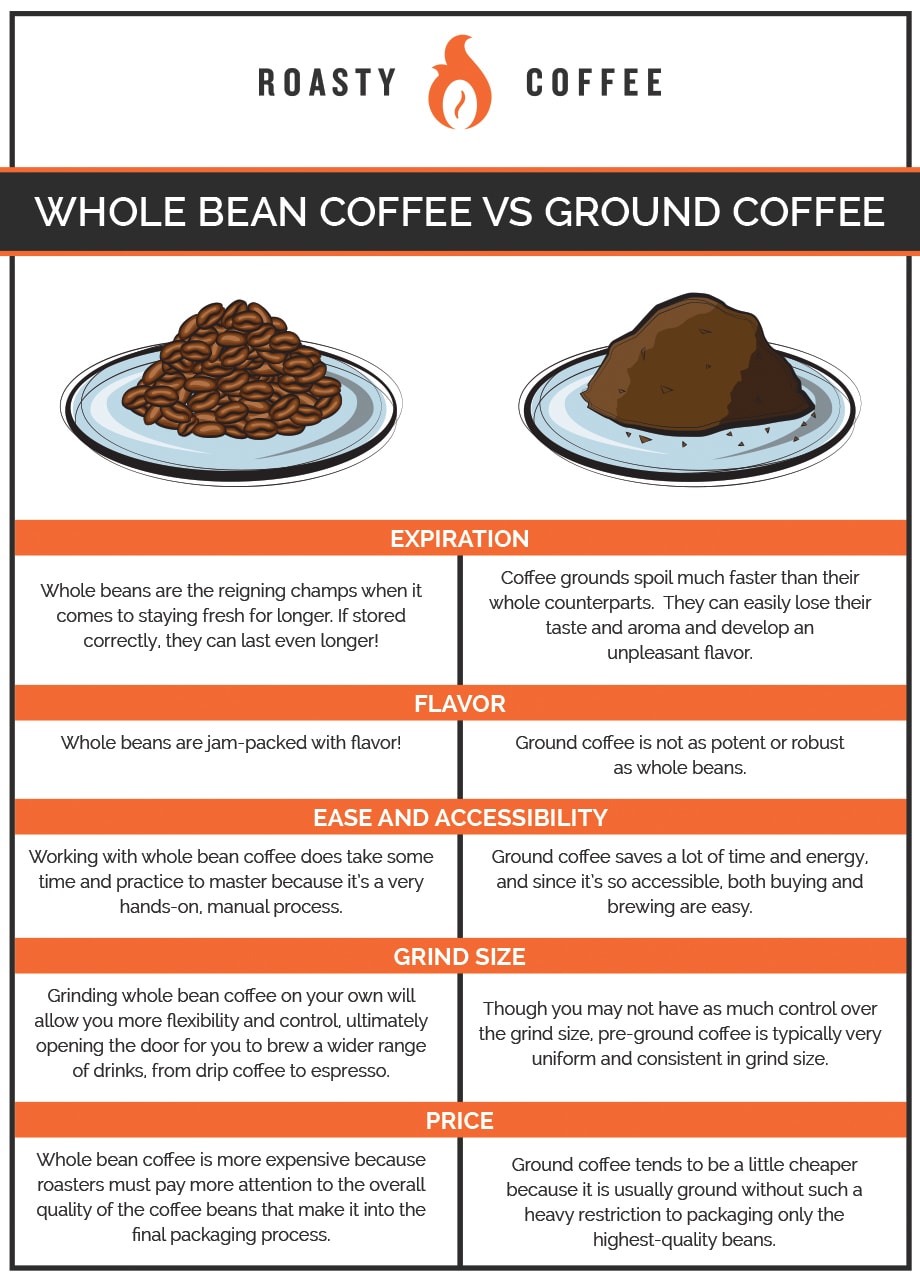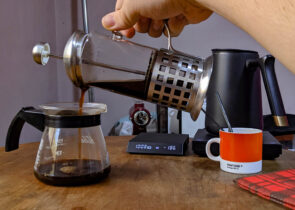To many coffee lovers out there, a cup of coffee is just that: a cup of coffee. They don’t take the time to consider what the process of getting the beans to the cup was; they just know the result is delicious.
But there’s more to your coffee than meets the eye. No matter where your coffee beans hail from, they underwent a process that included harvesting, processing, and roasting before they were packaged and sold in one of two forms: whole beans or ground beans.
Whether you’re a connoisseur or a casual coffee drinker, deciding between whole and pre-ground beans is an important part of your coffee experience.
Why is that, you ask? Don’t worry. We’ve got all the information you need about whole bean versus ground coffee.

Whole Beans vs. Ground Coffee
Let’s break these beans down. What’s the difference between these two, anyway? The variations may not sound too important at first, but if you want to begin making coffee at home or simply desire to expand your palate, you’ll want to know the contrast between each type of coffee.
Whole Bean Coffee: The Solid Stuff
The main distinction between ground and whole bean coffee is pretty easy to spot since it lies in the physical form of the coffee itself.
Whole bean coffee is exactly what it sounds like: unground and still in coffee bean form. If you were to purchase a bag to brew at home, you’ll most definitely need a burr coffee grinder or a grinder of some sort to break down your whole beans into grounds. Once they’ve been broken down into grounds, you can begin making your coffee with your brewing method of choice.
Local roasters tend to sell their coffee in whole bean form to preserve the flavor and overall quality of the joe until you’re ready to brew it. It’s for that same reason roasters like to ship coffee in whole bean form, too.
We should also note: all coffee is roasted while the beans are still whole.
You might ask, “If I just have to grind the whole beans anyway, why wouldn’t I just buy whole beans in the first place?” We’re glad you asked, and we’re getting to that. Though we here at Roasty often find ourselves brewing a cup of joe with some great-tasting pre-ground coffee beans, whole beans do hold a special place in our hearts for a multitude of reasons (but we’ll get to that later).
Ground Coffee: The Nitty Gritty
Much like whole beans above, ground coffee is pretty self-explanatory. This coffee has been ground up and broken down after roasting and before packaging, so the bag of roasted coffee beans you buy is immediately ready to be used in the brew method of your choice.
Though pre-ground java won’t exactly boast the same bold flavors as fresh beans will, there are still many things to enjoy about ground coffee. Just ask drip brewer connoisseurs, for instance. It’s not uncommon for those who declare the automatic dripper their brewing method of choice to reach for a bag of pre-ground beans.
That’s because the products on the shelf at the grocery store are usually the optimal grind size for a drip coffee maker, saving you valuable time and energy as you make your morning cup. A bonus: there’s usually a wide variety of blends and roasts to choose from!
Comparing The Two Coffees
Now that we know what each has to offer, let’s dive deeper into the whole bean versus ground coffee debate and play the coffee comparison game.
Expiration
The expiration date is a key factor to consider before purchasing both whole beans and pre-ground coffee. Coffee always tastes best when it is fresh, and that’s why it’s important to know how to store it. And, just as you might assume, these two types of coffee need to be stored differently.
Let’s start with whole beans. After fresh coffee beans are roasted, they slowly lose their freshness over time. And that loss is accelerated once the beans are ground. So, whole beans are the reigning champs when it comes to staying fresh for longer. That’s why so many coffee aficionados prefer them — they create a more flavorful, robust, and aromatic cup.
As we mentioned above, after the beans are physically broken down, they become more susceptible to humidity, heat, and the elements in general. That’s why coffee grounds spoil much faster than their whole counterparts. The coffee granules can easily lose their taste and aroma and develop an unpleasant flavor, especially if they’re not stored properly.
This is why it’s important to keep your whole and ground coffee in an airtight container that’s tucked away from light, heat, and moisture, preferably in a cool, dark cabinet. Doing this will keep your precious joe ready to brew on any occasion. And it’ll probably save you a couple of bucks and a trip to the grocery store to replace your lackluster coffee.
Flavor
Not only do whole beans tend to be the freshest, but they are also widely loved by coffee connoisseurs because they’re jam-packed with flavor. Since they’re not physically processed or further broken down after roasting, most of the coffee’s nuanced flavors are preserved. That’s why roasters prefer to sell their bags of coffee in whole bean form — to hang onto the delicious flavors and aromas for the customers’ satisfaction.
Though it may not be as potent or robust as whole beans, ground coffee can still be enjoyed. If you don’t mind sacrificing a little bit of flavor, it can still produce a pot of delicious coffee. Besides, ground coffee tends to be the preference of many coffee drinkers because it’s easier to mix and match flavors with it and create a wide range of roasts and blends.
Ease and Accessibility
Whether you enjoy the finer things in life, like a slow morning of manual brewing at home, or you like to keep the brewing process as simple and fast as possible before you run out the door for work, there is a difference between the levels of ease and accessibility between whole bean and ground coffee.
Beans are ideal for those budding baristas who like to play a role in the grinding process and experiment with brewing methods at home. However, working with whole bean coffee does take some time and practice to master because it’s a very hands-on, manual process…not to mention you have to grind it yourself!
Many go for pre-ground coffee because it saves a lot of time and energy, and since it’s so accessible, both buying and brewing are easy. You save yourself the chore of whipping out the coffee bean grinder; all you have to do is scoop grounds and get to brewing.
Grind Size
When it comes to coffee, whether you’re grinding the beans yourself or purchasing one of the many bagged options that are already ground, an important factor to consider is coffee grind size. The most information you need to know about grind size is that it directly correlates to the thickness or thinness of the surface area of the coffee itself.
If you’re going to brew coffee at home, it won’t be long before you realize you need to understand the difference between each particle size, from a coarse grind to fine.
The good news is that grinding coffee on your own will allow you more flexibility and control, ultimately opening the door for you to brew a wider range of drinks, from drip coffee to espresso. And if you plan to grind your whole beans yourself, we recommend you invest in a burr grinder (though their typically lower prices may be tempting, we suggest you steer clear of blade grinders!) to get the job done.
In contrast, for those who don’t have a burr grinder or are less interested in freshly ground coffee, a pre-ground product is an easier option because it saves you a step in your coffee-making process. Furthermore, though you may not have as much control over the grind size, pre-ground coffee is typically very uniform and consistent in grind size.
Still, there are pre-ground options that are more coarse or fine than others, so be sure to look at the packaging closely before you buy to be sure you’re purchasing the correct grind size for your desired brewing method.
Which Is Cheaper?
Another factor to consider when deciding between whole beans and ground coffee is the cost. Usually, whole bean coffee is more expensive because roasters must pay more attention to the overall quality of the coffee beans that make it into the final packaging process.
Before beans are roasted, they are filtered to weed out mutated or low-quality coffee beans. This ensures only healthy, robust beans make it into the roasting batch. The filtration process allows the roast to be as wholesome in flavor as can be, and because of the additional labor required to do this, the cost may be slightly higher as a result. One primary example of this is exotic coffee, in which the roasters sell whole beans that have been carefully selected to provide the consumer with the most authentic and desirable flavor.
On the other hand, ground coffee also tends to be a little cheaper because it is usually ground without such a heavy restriction to packaging only the highest-quality beans. However, this is also why ground coffee is more common, because not only is it more readily available to the consumer, but it’s also easier for roasters to export.
Frequently Asked Questions
Does pre-ground coffee work well in coffee makers?
Most pre-ground coffees are typically ground to a size that works best with automatic drip coffee makers, and unless their packaging says otherwise, a bag of pre-ground beans likely won’t work as well with other brewing methods.
The French press, for example, is best when used with coffee that’s a bit coarser than most pre-ground offerings. The AeroPress, on the other hand, needs beans that are finer than the joe you’re likely to find on the shelves of your grocery store.
This doesn’t mean you can’t use already ground beans in brewing methods besides automatic drippers, but if you want to make a decent cup of joe, you’ll probably need to do a little bit of experimenting and research to figure out what works best.
Does grinding your own coffee taste better?
Most serious coffee drinkers answer this question with an emphatic yes! As we mentioned above, each of your favorite brewing methods requires a different grind size for optimal flavor and caffeine extraction. And of course, grinding the coffee yourself gives you total control of the size of your grounds.
You might also find the size of your ground coffee affects the overall taste of your morning cup. But don’t worry; with a bit of practice, experimentation, and a good burr grinder, you’ll perfect the process in no time.
Helpful grind tip: you may be grinding your beans a bit too coarsely if the contents of your cup are more acidic than normal, and if your java is on the bitter side, your grounds are likely too fine.
What lasts longer, coffee beans or ground coffee?
Before we answer this question, we think it’s a good idea to again highlight the importance of properly storing your unused coffee. But in general, a batch of whole beans can be kept for a longer period of time than ground coffee.
If the package is still sealed, whole coffee beans can stay on your pantry shelf for six to nine months past the printed date. Unopened ground beans, on the other hand, can only last for three to five months past the printed date.
It’s a slightly different story when the coffee’s been opened, but still, whole beans can stick around longer. When stored properly, your beans can last for about six months, but grounds are only good for about three to five months.
Is grinding your coffee at home more satisfying?
We’ll be the first to admit that carving out a few extra minutes in your morning routine to grind beans isn’t necessarily the most convenient thing (especially when you’re already running late), but in our opinion, the answer to the above question is yes for a few reasons.
First, as we mentioned, it gives more control, and who doesn’t love being in control? Plus, the resulting cup will probably be more delicious and full than one brewed with pre-ground coffee, as the whole beans haven’t lost as much flavor as their already ground counterparts have.
Sure, grinding your own beans requires a bit more effort on your part, but trust us when we say the work will be worth it and the result extra satisfying.
So…Which Coffee Is Best For You?
Ultimately, the victor between whole bean coffee and ground coffee is up to you, but if you ask us, whole beans are the best.
If you’re looking for the highest quality and most flavor-filled coffee possible, then you’ll want to begin looking into whole bean coffee. Plus, if your goal is to brew coffee with a more manual method, then you’ll want to experiment with whole bean coffee to begin grinding, measuring, and making coffee on your own.
Likewise, if your main concern is convenience, then pre-ground coffee is going to be your go-to. This is arguably one of the most favorable features of ground coffee, as it’s made its way into many homes across a multitude of social classes.
So if you’re interested in trying one or the other, take a trip to the store or your local coffee shop or roaster, purchase a bag of beans or grounds, and start experimenting!
Happy caffeinating!







